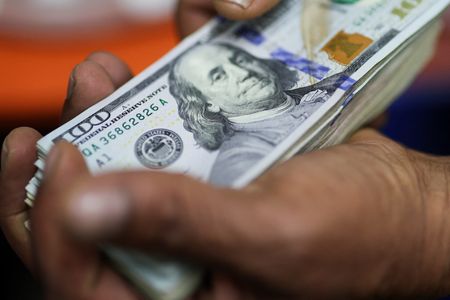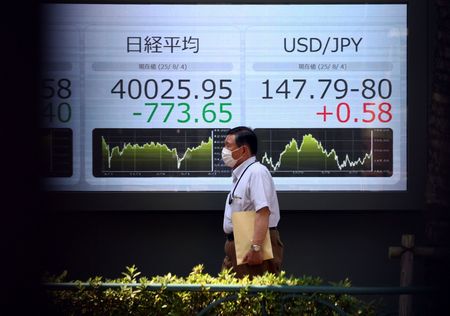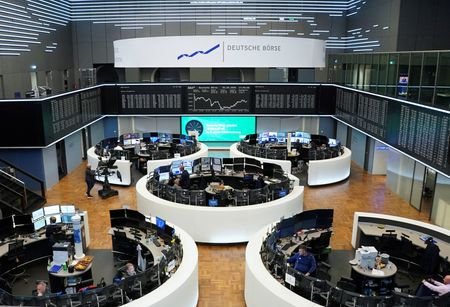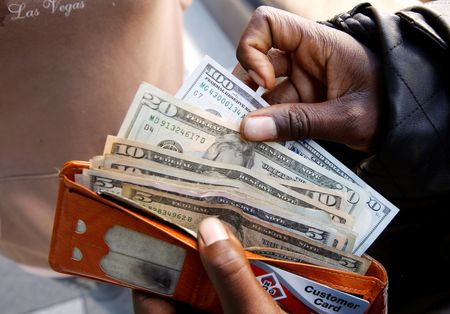By Ankur Banerjee
SINGAPORE (Reuters) -The U.S. dollar wobbled on Tuesday as investors braced for a possible U.S. government shutdown that would delay release of the crucial jobs report this week, while the Australian dollar rose after the central bank struck a cautious tone on inflation.
The Aussie gained 0.49% to $0.66075 after the Reserve Bank of Australia held rates steady as expected. The bank said recent data suggested inflation might be higher than forecast in the third quarter and the economic outlook remained uncertain.
This year, the RBA cut rates in February, May and August, with markets seeing little chance of a further easing this week. A high reading on monthly consumer prices had argued for waiting for the full third-quarter inflation report due in late October.
“The RBA statement leaned on the hawkish side by noting the tension in the economic data flow and the upside surprise to inflation from last week,” said Carol Kong, currency strategist at Commonwealth Bank of Australia.
“We retain our call for a 25bp rate cut in November but note a cut is not guaranteed and dependent on the Q3 25 CPI print.”
The Aussie has gained over 6% this year, benefiting from a weaker U.S. dollar and strong risk appetite. For September, it has advanced a more modest 0.6% after hitting an 11-month high two weeks ago.
Investor focus is on the looming U.S. shutdown, with the government funding due to expire at midnight on Tuesday unless Republicans and Democrats agree to a last-minute temporary spending deal.
The U.S. Labor and Commerce departments said their statistics agencies would halt economic data releases in the event of a partial government shutdown, including closely watched employment data for September.
Subadra Rajappa, head of U.S. rates strategy at Société Générale, said the initial reaction could be a sell-off in risky assets and a flight to safety, which may lead to lower Treasury yields and a steeper yield curve.
The payrolls report, crucial for decision-making by policymakers at the Federal Reserve, is scheduled for Friday, and a delay could leave the central bank flying blind on the labour market.
Federal Reserve Bank of New York President John Williams said on Monday that emerging signs of weakness in the labor market drove his support for cutting rates at the most recent policy meeting.
Traders are currently pricing in 42 basis points of Fed easing by December and a total of 104 basis points by the end of 2026, about 25 bps less than levels seen in mid-September.
“If a shutdown is brief, the Fed will largely ignore it,” said Elias Haddad, senior markets strategist at Brown Brothers Harriman.
“However, a prolonged shutdown (more than two weeks), increases the downside risk to growth and raises the likelihood of a more accommodative Fed.”
That could put the dollar in a vulnerable position in the near term, with the broader U.S. currency index, which has dropped 9.7% this year, at 97.928. The euro was a shade lower at $1.172, while sterling was at $1.3436.
Benchmark 10-year Treasury yields were little changed at 4.142%, after dropping 4.6 bps on Monday. They have dropped 8.3 bps for the month.
“While a shutdown could delay Friday’s non-farms payrolls report, historically, the impact on GDP has been modest, as any disruptions are typically made up immediately after the shutdown ends,” said Tony Sycamore, market analyst at IG.
The Japanese yen was slightly weaker at 148.72 per U.S. dollar as investors considered the Bank of Japan’s summary of opinions for its September policy meeting that showed the central bank debated the possibility of a near-term rate hike.
At its September meeting, the BOJ kept rates steady but faced dissents from two board members who voted for a rate hike. Traders are increasingly gearing up for the BOJ to hike interest rates again with a move in December priced in at a 60% chance.
(Reporting by Ankur Banerjee in SingaporeEditing by Shri Navaratnam and Lincoln Feast.)










